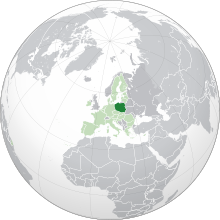Poland
Republic of Poland Rzeczpospolita Polska(Polish) | |
|---|---|
| Anthem:"Mazurek Dąbrowskiego"[a] ( "Poland Is Not Yet Lost" ) | |
Location ofPoland(dark green) – on theEuropean continent(green & dark grey) | |
| Capital and largest city | Warsaw 52°13′N21°02′E/ 52.217°N 21.033°E |
| Official language | Polish[1] |
| Ethnic groups (2021)[2] |
|
| Religion (2021[3]) |
|
| Demonym(s) |
|
| Government | Unitary parliamentary republic |
| Andrzej Duda | |
| Donald Tusk | |
| Legislature | Parliament |
| Senate | |
| Sejm | |
| Formation | |
| c.960 | |
| 966 | |
| 18 April 1025 | |
| 1 July 1569 | |
| 24 October 1795 | |
| 11 November 1918 | |
| 17 September 1939 | |
| 22 July 1944 | |
| 31 December 1989[5] | |
| Area | |
• Total | 312,696 km2(120,733 sq mi)[6][7](69th) |
• Water (%) | 1.48 (2015)[8] |
| Population | |
• 2024 census | |
• Density | 122/km2(316.0/sq mi) (75th) |
| GDP(PPP) | 2024 estimate |
• Total | |
• Per capita | |
| GDP(nominal) | 2024 estimate |
• Total | |
• Per capita | |
| Gini(2022) | low |
| HDI(2022) | very high·36th |
| Currency | Złoty(PLN) |
| Time zone | UTC+1(CET) |
• Summer (DST) | UTC+2(CEST) |
| Date format | dd.mm.yyyy (CE) |
| Driving side | right |
| Calling code | +48 |
| ISO 3166 code | PL |
| Internet TLD | .pl[a] |
| |
Polandis a country in the eastern region ofCentral Europe.[14]Its official name isRepublic of Poland.It is on the east ofGermany(alongOderandLusatian Neisse). TheCzech RepublicandSlovakiaare to the south,UkraineandBelarusto the east, and theBaltic Sea,Lithuania,and theRussianexclaveKaliningradto the north. The total land area of Poland is about 312,679 km2[15](120,728 mi2), slightly larger than Oman. This makes Poland the 77th largest country[15]in the world with over 38.5 million people. Most Polish people live in large cities, including the capital,Warsaw(Polish:Warszawa),Łódź,Cracow(Polish:Kraków), the second capital of Poland (first wasGniezno),Szczecin,Gdańsk,WrocławandPoznań.
The word "Poland" was written officially for the first time in 966. In 1569, Poland formed a strong union with Lithuania called thePolish-Lithuanian Commonwealth.At some point in its history, it was the largeststatein Europe and became very influential. Eventually, after a slow decline, the Commonwealthcollapsedin 1795. Poland regained itsindependencein 1918 afterWorld War I.In 1921, Poland defeated Soviet Russia in thePolish-Soviet Warthat started in1919.
However, Poland lost independence again not long after the beginning ofWorld War II,after suffering a defeat by both theUSSRandNazi Germany.Although the government collapsed, the Polish people fought on by forming the largest and most effective resistance movement in Nazi-occupied Europe. It is most notable for disrupting German supply lines to the Eastern Front of WWII, providing military intelligence to theBritish,and for saving moreJewishlives in theHolocaustthan any otherAlliedorganization or government. After the war, Poland regained "independence" and became acommunist countrywithin theEastern Bloc.The new government was appointed byJoseph Stalinand was under the control of theSoviet Union.
In 1989, Poland ceased being a communist country and became aliberal democracy.Its change of government was the first in a series of events that led to the states of Eastern and Central Europe regaining theirindependenceand the fall of the USSR in 1991. After thedemocratic consolidation,Poland joined theEuropean Unionon 1 May 2004. Poland is also a member ofNATO,theUnited Nations,and theWorld Trade Organization.
History
[change|change source]Early history
[change|change source]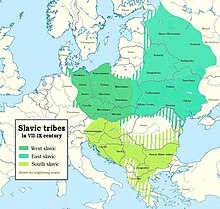
The first sign of humans in Polish lands was 500,000 years ago. TheBronze Agestarted around 2400-2300BC.TheIron Agestarted around 750-700BC.At that time the Polish lands were under the influence of theLusatian culture.About 400 BCCelticandGermanictribes lived there. Those people had trade contacts with theRoman Empire.
Over time,Slavscame to Polish lands. Some of those Slavs, now commonly referred to as Western Slavs (though in reality a diverse group of tribes with shared ethnic and cultural features), stayed there and started to create new nations. The most powerful tribe was called thePolans,who united all of the other Slavic tribes living there, and this is where the name "Poland" comes from.
Piast and Jagiellon dynasties
[change|change source]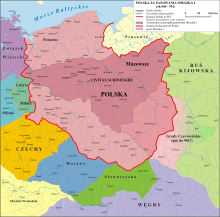
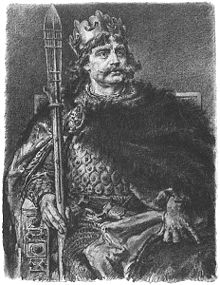
Poland began to form a country around the middle of the10th centuryin thePiast dynasty.In 966, PrinceMieszko Ibecame aChristian,and so the Polish people also became Christians. The next king wasBolesław I of Poland(called Bolesław the Brave). He conquered many lands and he became the first King of Poland.Casimir I of Polandchanged the Polish capital fromGnieznotoKraków.In the 12th century, Poland broke into some smallerstatesafter the death of KingBolesław III Wrymouthin 1138 because of hiswill.Those states were later attacked byMongolarmies in 1241, which slowed down the unification of the small states into the big country of Poland. This happened eighty years later, in 1320 whenWładysław Ibecame the King of United Poland. His sonCasimir IIIthe Great reformed the Polish economy, built new castles, and won the war against theRuthenian Dukedom.Many peopleemigratedto Poland, becoming a haven for emigrants. ManyJewishpeople also moved into Poland during that time. TheBlack Death,which affected many parts ofEuropefrom 1347 to 1351, did not come to Poland.[16]
After the death of the last Piast on the Polish throne,Casimir III,Louis I of Hungaryand his daughterJadwiga of Polandbegan their rule. She married theLithuanianprinceJogaila.Their marriage started a new dynasty in Poland: theJagiellon dynasty.Under theJagiellon dynasty,Poland made an alliance with its neighborLithuania.
Polish-Lithuanian Commonwealth to Second Republic of Poland
[change|change source]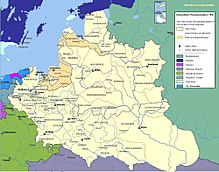
In the 17th centurySwedenattacked almost all of Poland (this was called “the Deluge” ). Many wars against theOttoman Empire,Russia,Cossacks,TransylvaniaandBrandenburg-Prussiaended in 1699. For the next 80 years, the government and the nation were weak, making Poland dependent on Russia. Russiantsarstook advantage of this by offering money to dishonest members of the Polishgovernment,who would block new ideas and solutions.Russia,Prussia,andAustriabroke Poland into three pieces in 1772, 1793 and 1795, which dissolved the country. Before the second split, aConstitutioncalled "The Constitution of 3 May"was made in 1791.
Napoleonmade another Polish state, “theDuchy of Warsaw”,but after theNapoleonic wars,Poland was split again by the countries at theCongress of Vienna.The eastern part was ruled by the Russian tsar. The Polish people did not like the new kings, and often rebelled (two bigrebellionsin 1830[16]and 1863[17]). DuringWorld War Iall theAlliesagreed to save Poland. Soon after thesurrender of Germanyin November 1918, Poland became theSecond Polish Republic(II Rzeczpospolita Polska). It got its freedom after several military conflicts; the largest was the 1919-1921Polish-Soviet War.
World War II
[change|change source]
On September 1, 1939,World War IIstarted whenNazi Germanyattacked Poland.TheSoviet Unionattacked Poland on September 17, 1939.Warsawwas defeated on September 28, 1939. Poland was split into two pieces, one half owned by Nazi Germany, the other by the Soviet Union. More than 6 million Polish people died, and half of these people wereJewish.Most of these deaths were part of theHolocaust,in which 6 million Jews and1.5poles were killed. At the war's end, Poland's borders were moved west, pushing the eastern border to theCurzon line.[18]The western border was moved to theOder-Neisse line.The new Poland became 20% smaller by 77,500 square kilometers (29,900 sq mi). The shift forced millions of Poles, Germans, Ukrainians, and Jews to move.
Polish People's Republic to Third Polish Republic
[change|change source]
After these events, Poland gradually became acommunistcountry. It was supposedly an independent country, but in reality, the new government was appointed byJoseph Stalinand was also under the control of theSoviet Union.The country was then renamed thePeople's Republic of Poland.There are many Poles in the neighboring countriesUkraine,Belarus,and Lithuania (these three countries were part of the Soviet Union until 1991), as well as in other countries. Most Poles outside of Poland are in the United States, especially inChicago.Germany and theUnited Kingdomare also home to a large Polish diaspora. The most recent mass emigration of Poles to western countries began after 1989.
In 1989Solidarity- atrade unionled byLech Wałęsa- helped defeat the communist government in Poland. Even before that event, Lech Wałęsa was given aNobel Prizefor leading the first non-communist trade union fighting for democracy in theCommunist Block.When Communism ended in Poland there were many improvements in human rights, such asfreedom of speech,democracy,etc. In 1991 Poland became a member of theVisegrad Groupand joinedNATOin 1999 along with theCzech RepublicandHungary.Polish voters then voted to join theEuropean Unionin a vote in June 2003. The country joined theEUon May 1, 2004.
Currently, the Prime Minister isMateusz Morawiecki.On 10 April 2010 the PresidentLech Kaczyńskidied in a government plane crash inSmolenskinRussia.The president is elected directly by the citizens for a five-yearterm.The Prime Minister is appointed by the President and confirmed by the "Sejm". The Sejm is the lower chamber of Parliamentlegislaturefor the country. It has 460 deputieselectedevery four years.
Geography
[change|change source]
Poland's territory is aplainreaching from theBaltic Seain the north to theCarpathian Mountainsin the south. Within that plain, the land varies from east to west.
The Polish Baltic coast is mostly smooth but has naturalharborsin theGdańsk-Gdyniaregion andSzczecinin the far northwest. This coast has severalspits,dunes,and coastal lakes. Coast lakes are formerbaysthat have been cut off from the sea. These areas are sometimes called lagoons.Szczecin Lagoonis on the western border withGermany.TheVistula Lagoonis on the eastern border withKaliningrad,province ofRussia.The longest river in Poland, theVistulariver, empties into theVistula Lagoonand also directly into theBaltic Sea.
The northeastern region is densely wooded, sparsely populated, and lacks agricultural and industrial resources. The geographical region has four hillydistrictsofmorainesand lakes created by moraines. These formed during and after thePleistoceneice age.The Masurian Lake District is the largest of the four districts and covers much of northeastern Poland.
Poland has many lakes. In Europe, onlyFinlandhas more lakes. The largest lakes areŚniardwyandMamry.In addition to the lake districts in the north, there are also many mountain lakes in theTatras mountains.
South of the northeastern region is the regions ofSilesiaandMasovia,which are marked by the broad ice-age rivervalleys.The Silesia region has many resources and people.Coalis abundant. Lower Silesia has largecoppermining.Masovian Plainis in central Poland. It is in the valleys of three large rivers:Vistula,BugandNarew.
Further south is the Polish mountain region. These mountains include theSudetesand theCarpathian Mountains.The highest part of the Carpathians is the Tatra mountains which is along Poland’s southern border. The tallest mountain in Poland,Rysyat 2,503 m (8,210 ft), is in theHigh Tatras.
Climate
[change|change source]Poland has acontinental climate.
The highest temperature ever recorded in Poland was 40.2 °C (104.4 °F) on 29 July 1921 in Prószków. The lowest temperature ever recorded in Poland was −41.0 °C (−41.8 °F) on 11 January 1940 in Siedlce.
Top 5 warmest days
| Rank | Temperature | Date | Location |
|---|---|---|---|
| 1. | 40.2 °C (104.4 °F) | 29 July 1921 | Prószków |
| 2. | 38.4 °C (101.1 °F) | 19 June 2022 | Słubice |
| 3. | 38.2 °C (100.8 °F) | 26 July 2019 | Radzyń |
| 4. | 37.6 °C (99.7 °F) | 20 July 2022 | Wrocław |
| 5. | 37.3 °C (99.1 °F) | 1 August 2020, 13 July 2010 | Kikoły, Hajnowka |
Administrative divisions
[change|change source]Poland is made of sixteenregionsknown asvoivodeships(województwa,singular -województwo). They are basically created from the country's historical regions, whereas those of the past two decades (till 1998) had been focused on and named for separate cities. The new units range in areas from under 10,000 km2(Opole Voivodeship) to over 35,000 km2(Masovian Voivodeship). Voivodeships are controlled by voivod governments, and their legislatures are calledvoivodeship sejmiks.
The sixteen voivodeships that make up Poland are further divided intopowiaty(singularpowiat), second-level units ofadministration,which are about the same as to acounty,districtorprefecturein other countries.
|
||||||||||||||||||||||||||||||||||||||||||||||||||||||||
Literature
[change|change source]
Almost no Polish literature remains beforeChristianisationin the10th century.Polish literature was written in theLatin languageduring theMiddle Ages.ThePolish languagewas accepted as equal to Latin after theRenaissancefor literature.
Jan Kochanowskiwas a leading poet ofEuropean Renaissanceliterature in the16th century.Other great Polish poets includeAdam Mickiewiczwho wrotePan Tadeuszepic in 1834.
Several Polish novelists have won the Nobel prize.Henryk Sienkiewiczwon in 1905 dramatized versions of beginnings of Christianity (Quo Vadis).Władysław Reymontwon a Nobel prize in 1924. He wrote the novelChłopi,recently filmed.Olga Tokarczuk2018. Two Polish poets won Nobel prizes as well. One isCzesław Miłosz(1980) and the secondWisława Szymborska(1996).
Stanisław Lemis a famousscience fictionauthor in the modern era. HisSolarisnovel was made twice into a featurefilm.
People
[change|change source]
In the past, Poland was inhabited by people from different nations and of different religions (mainlyCatholics,OrthodoxandJudaism). This changed after 1939, because of theNaziHolocaustwhich killed many Polish Jews. AfterWorld War II,the country was changed into acommunistcountry, by theWarsaw Pactwhich included most central European countries and RussiaRussia.
Today 38,038,000 people live in Poland (2011). In 2002 96.74% of the population call themselves Polish, while 471,500 people (1.23%) claimed another nationality. 774,900 people (2.03%) did not declare any nationality. Nationalities, orethnic groupsin Poland areSilesians,Germans(most in the formerOpole Voivodeship),Ukrainians,Lithuanians,Russians,Jews,RomaandBelarusians.ThePolish languageis part of theWest Slavicsection of theSlavic languages.It is also theofficial languageof Poland.EnglishandGermanare the most common second languages studied and spoken.

In the past few years, Poland's population has gone down because of an increase inemigrationand a sharp drop in the birth rate. In 2006, the census office estimated the total population of Poland at 38,536,869, a very small rise from the 2002 figure of 38,230,080. Since Poland's accession to theEuropean Union,many Polish people have moved to work in Western European countries like theUnited Kingdomand theRepublic of Ireland.Some organizations state people have left because of highunemployment(10.5%) and better opportunities for work somewhere else. In April 2007, the Polish population of theUnited Kingdomhad risen to about 300,000 people and estimates predict about 65,000 Polish people living in theRepublic of Ireland.However, in recent years strong growth of the Polish economy and the increasing value of Polish currency (PLN) makes many Polish immigrants go back home. In 2007, the number of people leaving the country was lower than people who are coming back. Poland became an attractive place to work for people from other countries (mainly Ukraine).
A Polish minority is still present in neighboring countries of Ukraine, Belarus, and Lithuania, as well as in other countries. The largest number of ethnic Poles outside of the country can be found in theUnited States.
Famous people
[change|change source]- Fryderyk Chopin,a music composer.
- Joseph Conrad,born Józef Teodor Konrad Korzeniowski, an acclaimed author who however wrote in English.
- Nicolaus Copernicus,anastronomerwho showed that theEarthmoves around theSun.
- Maria Skłodowska-Curiediscoveredradiumandpolonium.
- Franciszek Kamieński,discoveredmycorrhiza.
- Tadeusz Kościuszko,an army commander who fought forUSA's and Poland's independence.
- Robert Kubica,aF1driver.
- Stanisław Lem,ascience fictionwriter.
- Adam Małysz,a ski-jumper.
- Adam Mickiewicz,apoet
- Pope John Paul II(earlier Karol Wojtyła). Before he became Pope, he was aBishopinKraków.
- Agnieszka Radwańska,female tennis player
- Władysław Reymont,anovelist
- Henryk Sienkiewicz,a novelist
- Kamil Stoch,a ski jumper
- Wisława Szymborska,awriter
- Andrzej Wajda,afilm director
- Lech Wałęsa,leader of "Solidarność" ( "Solidarity" ), he helped defeat the communist government in Poland andUSSRinfluence in Central and Eastern Europe
- Robert Lewandowski,a football player
- Czesław Miłosz,apoet
- Jan Matejko,apainter
Urban demographics
[change|change source]
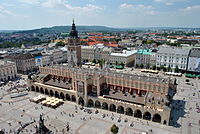


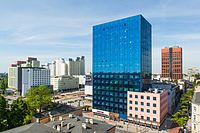



The lists below show the population count of Poland's largest cities based on 2005 estimates.
| Agglomerationorconurbation | Voivodeship | Inhabitants (Estimated, 2005) | |
|---|---|---|---|
| 1 | Katowice(USIA) | Silesia | 3,487,000 |
| 2 | Warsaw(Warszawa) | Masovia | 2,679,000 |
| 3 | Kraków | Lesser Poland | 1,400,000 |
| 4 | Łódź | Łódź | 1,300,000 |
| 5 | Tricity | Pomerania | 1,100,000 |
| 6 | Poznań | Greater Poland | 1,000,000 |
| City | Voivodeship | Inhabitants May 20, 2002 |
Inhabitants December 31, 2004 | |
|---|---|---|---|---|
| 1 | Warsaw(Warszawa) | Masovia | 1,671,670 | 1,692,854 |
| 2 | Łódź | Łódź | 789,318 | 774,004 |
| 3 | Kraków | Lesser Poland | 758,544 | 757,430 |
| 4 | Wrocław | Lower Silesia | 640,367 | 636,268 |
| 5 | Poznań | Greater Poland | 578,886 | 570,778 |
| 6 | Gdańsk | Pomerania | 461,334 | 459,072 |
| 7 | Szczecin | Western Pomerania | 415,399 | 411,900 |
| 8 | Bydgoszcz | Kuyavia-Pomerania | 373,804 | 368,235 |
| 9 | Lublin | Lublin | 357,110 | 355,998 |
| 10 | Katowice | Silesia | 327,222 | 319,904 |
| 11 | Białystok | Podlaskie | 291,383 | 292,150 |
| 12 | Gdynia | Pomerania | 253,458 | 253,324 |
| 13 | Częstochowa | Silesia | 251,436 | 248,032 |
| 14 | Sosnowiec | Silesia | 232,622 | 228,192 |
| 15 | Radom | Masovia | 229,699 | 227,613 |
| 16 | Kielce | Świętokrzyskie | 212,429 | 209,455 |
| 17 | Toruń | Kuyavia-Pomerania | 211,243 | 208,278 |
| 18 | Gliwice | Silesia | 203,814 | 200,361 |
| 19 | Zabrze | Silesia | 195,293 | 192,546 |
| 20 | Bytom | Silesia | 193,546 | 189,535 |
| 21 | Bielsko-Biała | Silesia | 178,028 | 176,987 |
| 22 | Olsztyn | Warmia-Masuria | 173,102 | 174,550 |
| 23 | Rzeszów | Subcarpathia | 160,376 | 159,020 |
| 24 | Ruda Śląska | Silesia | 150,595 | 147,403 |
| 25 | Rybnik | Silesia | 142,731 | 141,755 |
| 26 | Tychy | Silesia | 132,816 | 131,547 |
| 27 | Dąbrowa Górnicza | Silesia | 132,236 | 130,789 |
| 28 | Opole | Opole | 129,946 | 128,864 |
| 29 | Płock | Masovia | 128,361 | 127,841 |
| 30 | Elbląg | Warmia-Masuria | 128,134 | 127,655 |
| 31 | Wałbrzych | Lower Silesia | 130,268 | 127,566 |
| 32 | Gorzów Wielkopolski | Lubusz | 125,914 | 125,578 |
| 33 | Włocławek | Kuyavia-Pomerania | 121,229 | 120,369 |
| 34 | Tarnów | Lesser Poland | 119,913 | 118,267 |
| 35 | Zielona Góra | Lubusz | 118,293 | 118,516 |
| 36 | Chorzów | Silesia | 117,430 | 115,241 |
| 37 | Kalisz | Greater Poland | 109,498 | 108,792 |
| 38 | Koszalin | Western Pomerania | 108,709 | 107,773 |
| 39 | Legnica | Lower Silesia | 107,100 | 106,143 |
| 40 | Słupsk | Pomerania | 100,376 | 99,827 |
| 41 | Grudziądz | Kuyavia-Pomerania | 99,943 | 98,757 |
| 42 | Jaworzno | Silesia | 98,780 | 96,600 |
Related pages
[change|change source]Notes
[change|change source]- ↑"theDąbrowskiMazurka"
- ↑Multiple national identity was available in the census.
- ↑"The dukes (dux) were originally the commanders of an armed retinue (drużyna) with which they broke the authority of the chieftains of the clans, thus transforming the original tribal organization into a territorial unit."[4]
- ↑"Mieszko accepted Roman Catholicism via Bohemia in 966. A missionary bishopric directly dependent on the papacy was established in Poznań. This was the true beginning of Polish history, for Christianity was a carrier of Western civilization with which Poland was henceforth associated."[4]
References
[change|change source]- ↑Constitution of the Republic of Poland,Article 27.
- ↑"National Population and Housing Census 2021 Population. Size and demographic-social structure in the light of the 2021 Census results".
- ↑"Final results of the National Population and Housing Census 2021".Statistics Poland.
- ↑4.04.1"Poland".Encyclopedia Britannica.2023.Archivedfrom the original on 19 January 2024.Retrieved31 December2023.
- ↑"The Act of December 29, 1989 amending the Constitution of the Polish People's Republic".Internetowy System Aktów Prawnych.Archivedfrom the original on 19 October 2020.Retrieved18 October2020.(in Polish)
- ↑GUS."Powierzchnia i ludność w przekroju terytorialnym w 2023 roku".Archivedfrom the original on 22 September 2023.Retrieved19 October2023.
- ↑"Poland country profile".BBC News.12 November 2023.Archivedfrom the original on 21 October 2023.Retrieved12 November2023.
- ↑"Surface water and surface water change".Organisation for Economic Co-operation and Development(OECD).Archivedfrom the original on 24 March 2021.Retrieved11 October2020.
- ↑GUS."Resident population projection for Poland 2023-2060".stat.gov.pl.Retrieved2024-08-06.
- ↑Ptak, Alicja (2024-07-12)."Poland records EU's largest population decline".Notes From Poland.Retrieved2024-08-06.
- ↑11.011.111.211.3"World Economic Outlook Database, April 2024 Edition. (Poland)".International Monetary Fund.16 April 2024.Retrieved16 April2024.
- ↑"Gini coefficient of equivalised disposable income – EU-SILC survey".ec.europa.eu.Eurostat.Retrieved13 April2024.
- ↑"Human Development Report 2023/2024".United Nations Development Programme.19 March 2024.Archivedfrom the original on 19 March 2024.Retrieved19 March2024.
- ↑UN Statistics Division (1 April 2010)."Standard Country and Area Codes Classifications (M49)".United Nations Organization.Archivedfrom the original on 26 December 2018.Retrieved17 April2014.
- ↑15.015.1"Poland".The World Factbook(2024 ed.).Central Intelligence Agency.
- ↑16.016.1Teeple, J. B. (2002).Timelines of World History.Publisher: DK Adult.
- ↑Burant, Stephen R. (April 1, 1985)."The January Uprising of 1863 in Poland: Sources of Disaffection and the Arenas of Revolt".European History Quarterly.15(2). Sage Journals: 131–56.doi:10.1177/026569148501500201.ISSN0265-6914.S2CID143799338.Archivedfrom the original on May 21, 2021.RetrievedJuly 20,2020.
- ↑In first version of that line westernUkrainewithLvivmay come to Poland
Other websites
[change|change source]| Definitionsfrom Wiktionary | |
| Mediafrom Commons | |
| News storiesfrom Wikinews | |
| Quotationsfrom Wikiquote | |
| Source textsfrom Wikisource | |
| Textbooksfrom Wikibooks | |
| Learning resourcesfrom Wikiversity | |
- Tourist information portal
- Poland.gov.pl - Polish national portalArchived2008-10-29 at theWayback Machine
- Ministry of Foreign Affairs
- Poland at the World FactbookArchived2019-08-18 at theWayback Machine
- Background Note: Poland
- WorldFlicks in Poland: photos and interesting places on Google MapsArchived2008-05-03 at theWayback Machine



